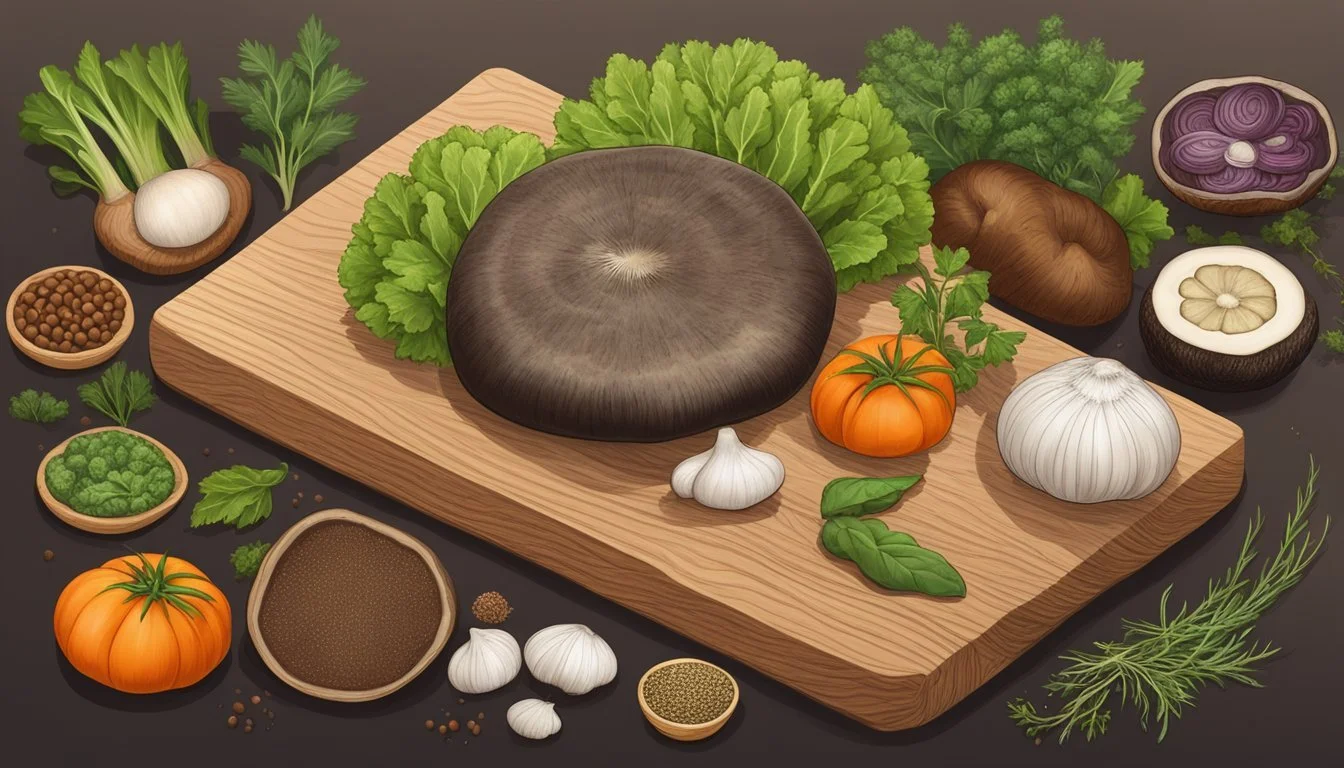Portobello Mushrooms Substitutes
The Best Alternatives for Your Recipes
Searching for a versatile substitute for portobello mushrooms can be essential if you're out of stock or looking for a new twist in your recipes. Shiitake mushrooms stand out as an excellent alternative due to their meaty and savory flavor profile, making them perfect for grilling, roasting, and sautéing. Whether added to a stir-fry or used as a burger patty replacement, shiitake mushrooms can rise to the challenge.
Another fantastic substitute is zucchini. This spongy vegetable excels in absorbing and retaining flavors while adding bulk and texture to dishes. It's particularly suitable for casseroles and stews, subtly blending into the mix without overpowering other flavors.
For those looking for a non-vegetable option, tofu is a great choice. Tofu's mild flavor and remarkable ability to soak up other flavors make it a suitable stand-in for portobello mushrooms. When fried on high heat, tofu offers a texture and taste reminiscent of the beloved mushroom. Each of these substitutes can help maintain the rich texture and depth of your favorite recipes, ensuring delightful culinary experiences.
Understanding Portobello Mushrooms
Portobello mushrooms are known for their meaty texture and deep, earthy flavor, making them a versatile ingredient in various culinary applications. They offer numerous nutritional benefits, often becoming a focal point in recipes as a meat substitute.
Texture and Flavor Profile
Portobello mushrooms have a firm and chewy texture. Their caps are broad and flat, providing a satisfying meaty feel when cooked. The flavor of portobellos is distinctively earthy, with a robust umami profile that deepens as the mushroom matures.
When grilled or roasted, these mushrooms develop a slightly smoky taste, enhancing their overall richness. Their texture and flavor make them an ideal foundation for hearty dishes.
Nutritional Benefits
Portobello mushrooms offer several nutritional advantages. They are a good source of protein, making them valuable in vegetarian and vegan diets. They contain essential vitamins such as B vitamins, including riboflavin, niacin, and pantothenic acid.
They also provide important minerals like iron and potassium. Rich in fiber, portobellos support digestive health. These mushrooms are also low in calories and contain antioxidants, contributing to overall wellness and immune support.
Culinary Uses of Portobellos
Portobello mushrooms can be used in a wide array of dishes due to their versatile nature. They can be grilled and served as a main dish or used as hearty burger patties. They work well fried, sautéed, or roasted in stews, soups, pizzas, and pasta.
Stuffed portobellos are a popular recipe, allowing for a variety of fillings like cheese, breadcrumbs, and vegetables. They can also complement sandwiches, adding depth and texture. Their adaptability makes them a staple in many recipes aimed at enhancing flavor and nutritional value.
Popular Substitutes for Portobello Mushrooms
There are several alternatives to Portobello mushrooms that can replicate their meaty texture and rich flavor in various dishes. These substitutes include other mushroom varieties, vegetable replacements, protein-rich alternatives, and specialty options.
Other Mushroom Varieties
Shiitake Mushrooms: Shiitake mushrooms are an excellent substitute due to their earthy flavor and firm texture. They work well in stir-fries, grilling, and roasting. They offer a similar umami punch, making them ideal for many recipes that call for Portobellos.
Cremini Mushrooms: Cremini mushrooms, also known as baby bellas, are younger versions of Portobellos. They have a slightly nutty flavor and are versatile, suitable for salads, stir-fries, and grilling. Their smaller size allows them to blend well into various dishes.
Button Mushrooms: Though milder in flavor, button mushrooms can work as a substitute. They are readily available and can be sliced and used in a wide array of recipes, including salads and stir-fries. Their subtle taste doesn't overpower other ingredients.
Oyster Mushrooms: Oyster mushrooms offer a delicate, slightly seafood-like flavor. They can be used in stir-fries and salads. Their tender texture can mimic the softness of cooked Portobellos in many dishes.
Vegetable Replacements
Zucchini: Zucchini's spongy texture allows it to absorb flavors well, making it perfect for casseroles and stews. When sliced or cubed, it provides a bulk similar to that of mushrooms, without a strong flavor to dominate the dish.
Eggplant: Eggplant has a hearty texture and a mild flavor that works well as a Portobello replacement, especially in grilling and roasting recipes. Its ability to soak up flavors makes it a versatile substitute.
Sun-Dried Tomatoes: While they don’t offer the same texture, sun-dried tomatoes bring a rich, tangy flavor that can enhance various recipes. They are particularly effective in salads and Mediterranean dishes.
Leeks and Onions: Both leeks and onions can add an earthy depth to dishes. They are best used in sautéed or roasted form to complement or replace the flavor of Portobellos, providing a subtle sweetness and umami.
Protein-Rich Alternatives
Tofu: Tofu's texture can be quite similar to mushrooms, especially when cubed and cooked. It absorbs flavors well, making it an excellent substitute in stir-fries and grilling recipes. It also adds a protein boost.
Tempeh: Made from fermented soybeans, tempeh offers a nutty flavor and firm texture. It can be sliced thin or cubed and used in grilling or stir-fries, serving as a solid, protein-rich substitute for Portobellos.
Chickpeas: Also known as garbanzo beans, chickpeas can replace mushrooms in stews and casseroles. They offer a hearty texture and a mild, nutty flavor that works well in a variety of recipes.
Seitan: Seitan is made from wheat gluten and has a chewy texture similar to meat, making it a great substitute. It can be grilled, roasted, or cooked in stews, adding both texture and protein to the dish.
Specialty Substitutes
Dried Porcini Mushrooms: When rehydrated, dried porcini mushrooms provide a deep, earthy flavor. They can be used in place of fresh Portobellos in sauces, risottos, or soups for a rich umami boost.
Chanterelle Mushrooms: Known for their delicate, fruity flavor, chanterelles can be sautéed or added to recipes requiring a refined touch. They bring a unique taste that stands out in sophisticated dishes.
Artichoke Hearts: Canned or marinated artichoke hearts add a tangy and slightly sweet flavor, making them a unique replacement. They can be incorporated into salads, pasta dishes, and even grilled as a substitute.
Russet Potatoes: When diced or sliced, russet potatoes can add the starchy bulk needed in dishes like stews and casseroles. They don't provide the umami flavor but offer a comforting, hearty texture.
Culinary Techniques for Substitutes
Incorporating substitutes for portobello mushrooms requires a thoughtful approach to maintaining texture and flavor. Utilizing a variety of cooking techniques can enhance dishes and adapt recipes effectively.
Adapting Recipes for Substitutions
When replacing portobello mushrooms in recipes, pay attention to texture and flavor. Shiitake mushrooms provide a similar meaty texture and umami flavor, making them ideal for stews and pasta dishes. Eggplant or zucchini can be used in place of portobellos in grilled dishes, offering a slightly sweet and firm bite. Tofu and tempeh are excellent in stir-fries and soups, adding protein and a savory depth.
Adaptations:
Substitute shiitake mushrooms for a meaty texture.
Use eggplant in grilled recipes.
Apply tofu or tempeh in stir-fries.
Enhancing Flavors
Adding depth to dishes is essential when using substitutes. Soy sauce and Worcestershire sauce can elevate the umami flavor often provided by portobellos. Marinating substitutes like tofu or eggplant with these sauces before cooking intensifies the savory taste. Roasting vegetables like zucchini with herbs and garlic enhances their flavor. Cheese, when stuffed into substitutes, delivers richness and a satisfying bite.
Flavor Enhancements:
Use soy sauce for umami.
Marinate tofu/eggplant before cooking.
Roast vegetables with herbs and garlic.
Incorporate cheese in stuffing recipes.
Creative Cooking Ideas
Employ various culinary techniques to showcase substitutes. Grilling shiitake mushrooms can serve as a perfect pizza topping, adding a smoky element. Stuffed vegetables, like eggplant filled with herbs and cheese, make a hearty main course. For a quick and flavorful option, sauté tofu with soy sauce and mushrooms for a stir-fry. Roast mixed vegetables with a drizzle of olive oil for a delicious side dish in pasta meals.
Creative Ideas:
Grill shiitake mushrooms for pizza.
Stuff eggplant with herbs and cheese.
Sauté tofu for stir-fry.
Roast mixed vegetables for pasta.
Health and Dietary Considerations
When looking for substitutes for portobello mushrooms, several health and dietary factors should be considered. These include the carbohydrate content, vegetarian suitability, heart and immune system benefits, and the freshness and quality of potential replacements.
Low-Carb and Vegetarian Options
Crimini mushrooms, being younger versions of portobellos, can be a great low-carb and vegetarian alternative. They have similar textures and flavors, making them ideal in various recipes.
Tofu and tempeh are also excellent options due to their high protein content and versatility. Both are low in carbs, making them suitable for keto or low-carb diets. Moreover, tofu offers added benefits of being rich in minerals like calcium and iron.
Bamboo shoots provide a unique crunch and are low in carbohydrates. They absorb flavors well in dishes like stir-fries and soups, adding variety to a vegetarian menu.
Benefits for Heart and Immune System
Portobello substitutes often contain nutrients beneficial to heart health and immune function. Crimini mushrooms have similar nutrient profiles to portobellos, offering a good source of dietary fiber, which aids in lowering cholesterol levels.
Tofu is known for its heart-healthy properties, containing beneficial unsaturated fats and no cholesterol. Its consumption can help reduce risks linked to heart diseases.
Tempeh is rich in antioxidants and anti-inflammatory compounds, which are crucial for boosting the immune system. Additionally, tempeh provides probiotics that support gut health, an essential component of overall immunity.
Freshness and Quality in Substitutes
Ensuring the freshness and quality of substitutes is crucial for maintaining their nutritional value and taste. Fresh crimini mushrooms will have a firm texture and a rich, earthy flavor similar to portobellos.
Tofu and tempeh should be fresh and well-stored to prevent spoilage and retain their nutritional qualities. Always check expiration dates and store them according to package instructions.
For bamboo shoots, opt for fresh or well-preserved varieties to maintain their crunch and nutritional benefits. Fresh bamboo shoots are preferable, but canned versions can be acceptable if properly rinsed before use. Proper storage and selection ensure that these substitutes provide the maximum health benefits.
Mushroom Substitutes for Special Diets
When adapting recipes for special diets, it's crucial to find substitutes that maintain the texture and flavor of Portobello mushrooms. For those following gluten-free and vegan diets, options such as tofu, tempeh, and lentils can be excellent alternatives, while gourmet cooking can benefit from refined choices like eggplant and cauliflower.
Gluten-Free and Vegan Alternatives
Tofu: A versatile and protein-rich alternative, tofu is excellent for vegan and gluten-free diets. It absorbs flavors well and mimics the texture of mushrooms when cooked.
Tempeh: Made from fermented soybeans, tempeh offers a nutty flavor and firm texture. It's gluten-free and high in protein, making it suitable for various diets.
Lentils: Lentils provide a hearty texture and are great for soups and stews. They can replace mushrooms in dishes requiring a meatier, substantial ingredient.
Benefits:
Tofu: High in protein, versatile
Tempeh: Nutty flavor, fermented benefits
Lentils: Hearty texture, nutritious
Substitutes in Gourmet Cooking
Eggplant: Known for its meaty texture, eggplant works well in gourmet dishes like casseroles and sautés. It retains its shape when cooked and absorbs flavors effectively.
Cauliflower: This cruciferous vegetable can be roasted or sautéed to provide a satisfying crunch and a mild taste, enhancing gourmet recipes.
Zucchini: With its spongy texture, zucchini is effective in absorbing spices and seasonings, making it a good mushroom substitute in refined dishes.
Gourmet Benefits:
Eggplant: Meaty texture, flavor absorption
Cauliflower: Crunchy, mild flavor
Zucchini: Spongy, versatile
Together, these substitutes ensure your recipes not only cater to special dietary needs but also deliver gourmet flavor and texture.




